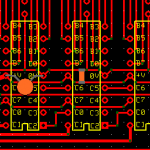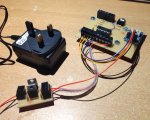Question: battery or power supply
I try to make some different projects with PICAXE 18M2, but has a lot of problems with noise when I use my profesional labaratorie power supply. nothing works as it should.
If I use a 9 Vdc battery and a regulator LM7805 so I have no problems and everything works perfectly
My question:
Is it only possible to use a battery - or is there a possibility to use a power supply and what can I do to avoid noise with my profesional labaratorie power supply.
I hope someone can give me some good advice and if someone has a diagram to solve the problem, I would be grateful
Yours sincerely
Tonny - Denmark
I try to make some different projects with PICAXE 18M2, but has a lot of problems with noise when I use my profesional labaratorie power supply. nothing works as it should.
If I use a 9 Vdc battery and a regulator LM7805 so I have no problems and everything works perfectly
My question:
Is it only possible to use a battery - or is there a possibility to use a power supply and what can I do to avoid noise with my profesional labaratorie power supply.
I hope someone can give me some good advice and if someone has a diagram to solve the problem, I would be grateful
Yours sincerely
Tonny - Denmark


